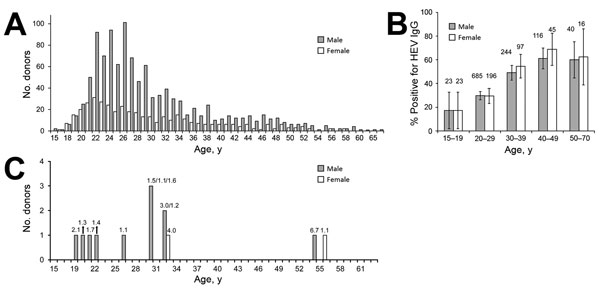Hepatitis E Virus Prevalence among Blood Donors, Ouagadougou, Burkina Faso
Kuan A. Traoré, Jean Bienvenue Ouoba, Hortense Rouamba, Yacouba K. Nébié, Honorine Dahourou, Frédéric Rossetto, Alfred S. Traoré, Nicolas Barro, and Pierre Roques

Author affiliations: Author affiliations: Université de Ouagadougou, Ouagadougou, Burkina Faso (K.A. Traoré, J.B. Ouoba, A.S. Traoré, N. Barro); Commissariat à l’Energie Atomique , Service d’Immuno-Virologie, Fontenay-aux-Roses, France (K.A. Traoré, F. Rossetto, P. Roques); INSERM, U1184, Fontenay-aux-Roses (K.A. Traoré, F. Rossetto, P. Roques); Université Paris-Sud XI, Orsay, France (K.A. Traoré, F. Rossetto, P. Roques); Centre Médical de Samandin, Ouagadougou (H. Rouamba); Centre National de Transfusion Sanguine, Ouagadougou (Y.K. Nébié, H. Dahourou)
Main Article
Figure

Figure. Age and sex distributions and HEV test results for blood donor population, Ouagadougou, Burkina Faso, 2014. A) All blood donors. Women: mean age 29.62 y, median 27 y, range 17–58 y; men: mean age 29.86 y, median 27 y, range 15–70 y. B) Donors whose samples were positive for HEV IgG. Numbers above bars indicate number of donors tested. Error bars indicate 95% CI for percentage in each category. C) Age and sex distribution of blood donors whose serum samples were positive for HEV IgM. Numbers on data bars are ratios of specific ELISA optical density to cutoff values (IgM index); ratios ≥1 are considered positive. Ratios are shown for each donor. HEV, hepatitis E virus.
Main Article
Page created: March 16, 2016
Page updated: March 16, 2016
Page reviewed: March 16, 2016
The conclusions, findings, and opinions expressed by authors contributing to this journal do not necessarily reflect the official position of the U.S. Department of Health and Human Services, the Public Health Service, the Centers for Disease Control and Prevention, or the authors' affiliated institutions. Use of trade names is for identification only and does not imply endorsement by any of the groups named above.
